
Catalog excerpts
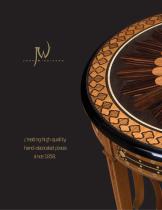
reating high quality, hand-decorated pieces since 1858.
Open the catalog to page 2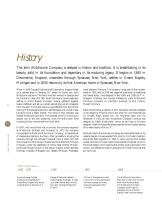
History The John Widdicomb Company is steeped in history and tradition. It is breathtaking in its beauty, solid in its foundation and legendary in its enduring legacy. It begins in 1845 in Devonshire, England, meanders through Syracuse, New York, settles in Grand Rapids, Michigan and in 2000 returns to its first American home in Syracuse, New York. John Widdicomb When in 1845 George Widdicomb left Devonshire, England he set up a cabinet shop in Syracuse NY where his fourth son, John Widdicomb was born. The family lived and worked in Syracuse and the Central NY area until 1857 when they...
Open the catalog to page 4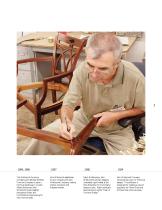
1894, 1896 The Widdicomb Furniture Company joins Stickley Brothers Furniture Company to open a furniture storehouse in London. Albert Stickley and John Widdicomb travel together throughout Britain and Continental Europe looking for new furniture ideas. 1897 John Widdicomb establishes his own company, the John Widdicomb Company, making interior woodwork and fireplace mantels. 1900 Ralph Widdicombe, John Widdicomb’s primary designer, is awarded a gold medal at the Paris Exposition for his moderne bedroom suite. Ralph eventually becomes known as the “Dean of Furniture Design.” 1924 John...
Open the catalog to page 5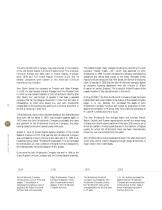
The John Widdicomb Company was instrumental in the creation of the the Grand Rapids Furniture Makers Guild. The American Furniture Market had been held in Grand Rapids, Michigan since 1878 and The Grand Rapids Furniture Guild and its related companies were leaders in the American furniture manufacturing industry. John Stuart joined the company as Director and Sales Manager in 1929. He later became General Manager and Vice President and in 1943 he was named President of John Widdicomb. Shortly after John Stuart, Inc. was formed. It appears it had been a separate company that ran the designer...
Open the catalog to page 6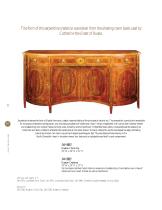
The form of this serpentine credenza was taken from the dressing room table used by Catherine the Great of Russia. John Widdicomb Its splendor evidences the fusion of English forms and a deeply ingrained feeling of the principles of national art. The composition is particularly remarkable for its compound serpentine configuration, and its sumptuous patterns of veneers and inlays. The top is resplendent with walnut book-matched veneers and crossbanding; oval inlays of maple and tulip wood, framed by walnut benchwork. Embellished doors, ebony inlays accentuate the posts and an inlaid holly...
Open the catalog to page 10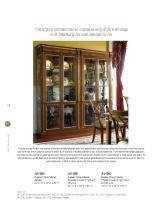
The original cabinets lined an impressive wing of the Hermitage in St. Petersburg, but were destroyed by fire. John Widdicomb This distinctively Russian neo-classical china cabinet features gilted dentil and egg-and-dart moulding that follows the horizontal line of the cornice; and the frieze, which contains inlays of Karelian birch outlined with ebony between a pair of brass medallions. The frames of the beveled glass doors and ends are also outlined in gilted egg-and-dart moulding while the corner posts contain Karelian birch inlays between a brass capital and base. The cabinet features a...
Open the catalog to page 12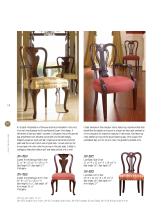
John Widdicomb An English interpretation of Baroque outlines is noticeable in the unity of curved lines displayed by this comfortable Queen Anne design. A refinement of scale and detail is evident in the gentle lines of the cabriole legs, embellished with delicately carved shell and foliated designs. Elegantly poised on small pad feet, it features carved scrolls where the posts meet the curved French walnut splat back. Carved scrolls on the sinuous open arm chair echo the carving on the back posts. Crafted in mahogany, these chairs feature pull-over seats outlined with a welt. Classic...
Open the catalog to page 16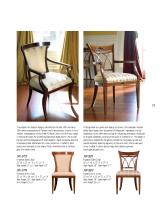
The passion for classical designs, rekindled by the late 18th and early 19th century excavations of Pompeii and Herculaneum, lives on in this modern interpretation of the Greek Klismos Chairs. While firmly rooted in the ancient past, the underlying features of these chairs—the curved top rail and the backposts with scroll designs—reach across the centuries to achieve a fresh refinement for a new millenium. Crafted in solid cherry and available in any cherry finish. Available with or without gold trim shown here. Distinguished by a grace and beauty of its own, this neoclassic Russian...
Open the catalog to page 17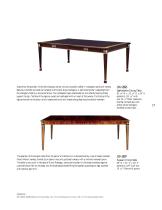
Inspired by the grandeur of the late Georgian period, this dining table, crafted in mahogany solids and veneers, features a chamfer-cornered top veneered with broken stripe mahogany. A satinwood border is separated from the mahogany field by a tulipwood stripe. Four pentagonal legs, accentuated on two sides by tapering flutes, support the top. The face of the legs are routed and addressed with an insert of fret overlay. The fluting of the legs carries over to the apron rails to create continuity and interest along these long horizontal members. The splendor of this Russian table from the...
Open the catalog to page 19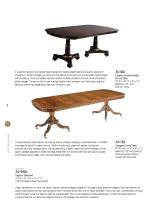
A substantial extension dining table featuring beautiful veneers, elegant details and quality construction throughout. The solid mahogany carved and turned feet are surmounted with concave-sided, tripartite bases. Solid mahogany, turned and tapered columns rise from the bases, complete with hand carved and optional gilded bracelets. The top is a field of book-matched, feather crotch mahogany with a short-grain edge and features a conforming, recessed apron optionally trimmed in gold. The trend towards magnificence in furnishings, bred by Georgian prosperity, is well exemplified in this...
Open the catalog to page 20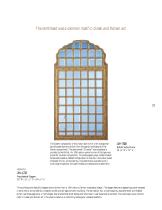
The ram’s head was a common motif in Greek and Roman art. The Eastern composition of this Indian syle mirror with its engrailed top silhouette borrows its form from the age-old architecture of the Indian subcontinent. The style termed “Oriental” was considered a curiosity by the British. An 18th century period mirror of this type was prized for its exotic romanticism. This extravagent piece, crafted of select hardwoods, boasts a coffered configuration of sixty-four individual pieces of beveled mirror, surrounded by a moulded frame available with a wide range of optional intricate finishes...
Open the catalog to page 23All STICKLEY catalogs and technical brochures
-
Selectionals By Stickley
48 Pages
-
Nichols & Stone
65 Pages
-
Stickley Classics
144 Pages
-
Fine Upholstery
188 Pages
-
Mission
260 Pages
-
Highlands
32 Pages
-
Studio By Stickley
24 Pages
-
Designer Rugs
62 Pages
-
Stickley Starters
12 Pages
-
Modern
128 Pages
-
Mission Oak & Cherry
252 Pages
-
Stickley Fine Upholstery & Leather
220 Pages
-
Classics
144 Pages














